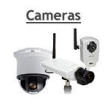
|
|
|
iCatcher Help
Learn how to set up and use iCatcher's features to their full potential. read more... File download areaDownload all the iCatcher software products, including legacy versions. read more... Wildlife picture galleryi-Catcher Wildlife captures fantastic scenes from nature. Have a look at some of the best. read more... Capture equipmentFind out about suitable equipment for use with iCatcher, from cameras to lighting, and more. read more... |
Connecting a network camera If you are adding a Network Camera, then the next screen will enable you to select from a list of supported cameras. Choose your manufacturer and model, and iCatcher Console will suggest a video type. The video type can normally be left as iCatcher Console suggests, and only needs to be changed if you are having trouble connecting to the camera. Enter the IP address and port of the camera, and if the camera is configured with a username and password, enter these in the boxes shown. Please note that Windows will not allow you to use a username with no password so if your camera comes configured like this, you will need to reconfigure it with both a username and password to use it in iCatcher Console. Video TypesPlease note that camera support for different video types varies, and while they may support a particular type, they are not always usable by other applications like iCatcher Console. Single JPEG imagesIf the video type is set to JPEG then iCatcher Console will continuously request single images from the camera. This is the most basic of the capture modes, and provides the lowest performance in terms of frames per second. Motion JPEG streamMJPEG, or Motion JPEG, provides higher performance than JPEG because iCatcher only needs to make a single request to the camera for the video, rather than requesting each image individually. Motion JPEG multi streamThis is similar to the normal motion JPEG stream, but allows you to use different sizes/quality of video for recording, viewing and motion detection/analytics. During configuration, you may be asked to specify the sizes to be used for each stream. MPEG streamMPEG, whilst providing the highest performing solution and is good for low bandwidth links, tends to be less suitable for CCTV video and there is more compression in the video and so detail can be lost. H.264 over RTSPH.264 and RTSP allow for viewing and recording much larger video while using lower quality/size video for the motion detection/analytics. This has the advantage of increasing performance and recording frame rate. When this type is selected, you will also be asked for the RTSP port which defaults to 554. During configuration, you may be asked to specify the sizes to be used for each stream. A separate visual stream allows you to display an H.264 stream that is different to the recording stream. This is not generally required but can be useful in special circumstances, for example with very high resolution cameras where you want to display a lower resolution image on your monitor, or where you want to see high resolution live video but don't need high resolution recorded. Custom devicesIf you have a device that is not listed in manufacturer or model lists, then you can still make use of it in iCatcher Console by selecting Custom as the manufacturer and model if you know the full URL to a single still JPEG image or a standard multipart MIME motion JPEG stream. If you do not have these details, or your device does not support them, please contact us as we may be able to find them out for you. |
